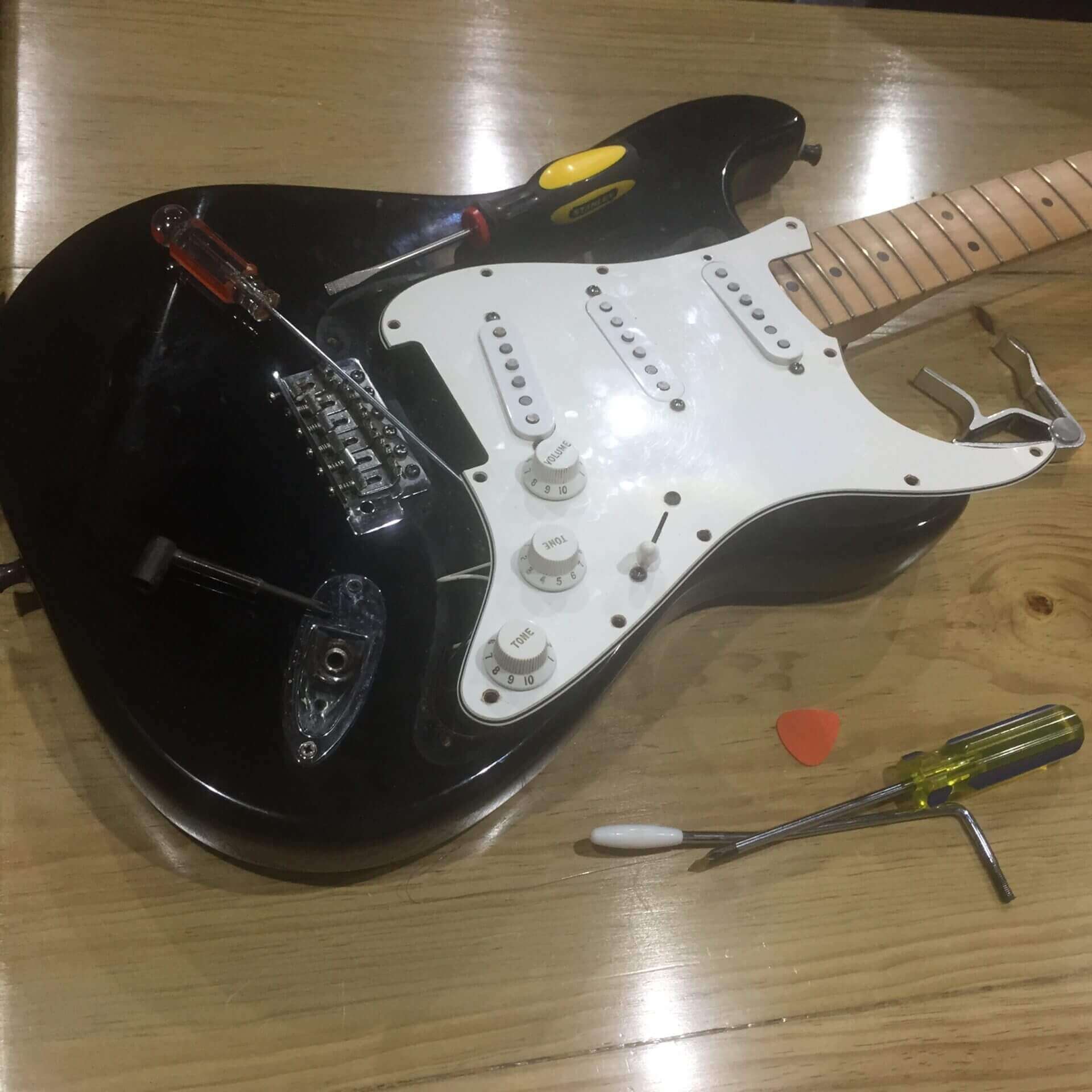I recently discovered that my electric guitars weren’t staying that well in tune anymore. So the first thing I did was send them to a guitar tech for service. Also, in my quest for that awesome perfect tone we all like to chase, I made some additional research myself, filling up some gaps in my knowledge. Boy did I discovered a lot of useful things. Some might have been obvious, some not quite, (at least for me.)
Anyway, here is list of useful things to know about setting up an electric guitar.
1. Guitar Pickups’ height, and its influence on string tuning.
Man, I love guitar pickups! I do. I could write a big rant about jut how much I’m in love with them. It’s one of the parts of the electric guitar that defines its sound the most. Swapping them can have some drastic effects on the voice of the guitar.
When you’re setting them up, you can push them farther away, or bring them closer to the strings. As you change their height you’ll get a very different character for the sound coming from your amp. You can make it brighter and more aggressive, or more mellow, with lots of dynamic range.
But did you know that the pickup’s height can also mess with the tuning? Set them too close to the strings, and the pickups, being mostly magnets, will mess with the vibration of the strings as you play. They could pull the strings too much, (and make your notes sound like they are wobbling all over the place, affecting their pitch), and also make you sound stiffer too, interrupting the vibration by its pull, thus killing your sustain.
It’s all about using your ears to set them up, but there’s also some useful guidelines that guitar manufacturers recommend for pickups’ height. I’d say use those guidelines at least as a starting point and then adjust to taste. On my Les Paul I had them too low, and on the Strat they were too high. I can assure you that, at least for me, after setting my pup’s to standard specs, they have never sounded sweeter.
2. Correct string height.
I’m hesitant to use the word “correct”, as string height, also called action, is a matter of personal preference. It’s always a compromise between easier playability, and rattle. Set the action too low and the guitar will be easier to play, but you will have the strings rattling against the frets. Set them too high and they’ll vibrate freely and sound beautiful, but they might prove more difficult to play.
As with pickups, manufacturers do recommend a standard string action for maximizing your electric guitar’s tone. I found out that I had my own guitars’ action set too low. I now have them set to standard height and I couldn’t be more pleased with the sound.
3. Learning about adjusting the Truss Rod
I confess that adjusting the Truss Rod was always a mystery to me, one better left to professional guitar tech gurus. Well, not anymore, and I’m happy to finally know what it’s all about.
The Truss Rod is a little metallic bar inside every electric guitar’s neck. Its purpose is to counteract the tension on the neck created by the strings . It does this by creating an opposite force, thus maintaining the guitar’s neck straight.
Things that can bend the neck on a guitar include, for example, weather changes, or putting a heavier or lighter set of strings on your guitar. If you always use the same gauge of strings, and keep your guitar well protected in its case when not in use, chances are you might never need to do a Truss Rod adjustment. It also doesn’t hurt to check your guitar for neck bending every now and then.
Adjusting the Truss Rod is actually a fairly simple process. You could easily do it yourself if you wanted too, or you could take your guitar to a tech to do it for you. It’s fine either way. But I’ll go ahead and say this: don’t get too nervous about doing it. Learn about it and try it yourself.
Like I said in the last two points, standard guitar manufacturers’ specifications are your best starting point. Also, the Web and YouTube videos. I recommend you watch this video, for example, in which it is further explained all I have mentioned till now.
4. Finger fretting strength
I don’t really know why this basic piece of knowledge had eluded me until now, considering I’ve been playing guitar for more than 20 years. But, did you know that the stronger you press a string, when you’re fretting it, the sharper in pitch it will sound?
I always thought that when fretting a string it will always give you the exact same pitch. Or I at least I just assumed that it did that, and never really thought it through. But I guess it makes sense. The harder you push it, the tighter you are making the string. Of course it results in a slightly sharper note. You can even make kind of a slight vibrato just by variating the strength you use while fretting the string.
Knowing that has helped me become a better and more sensitive player, as I’m not assuming anymore the “totally right” pitch will sound when I fret a note, but I’m actively hearing each note I play and reacting by adjusting my fretting strength to make it sound just about right. It sounds a bit harder, but I find it’s actually kinda fun. I think it’s also a very important thing to do when you’re playing chords too.
5. Intonation
This one I knew how to do. I believe it’s very basic thing, really. I’ll just add it here as quick reminder. Intonation is a very important step in setting up your guitar to the maximum of its potential. If you don’t know what I’m talking about do a quick google research, or feel free to send me a message. You’ll be intonating the strings of your guitar in no time.
6. How to efficiently stretch the strings
Stretching strings is something you have to do every time you change your old strings for a fresh set. This is something I always did in a very aggressive way, tightly pulling each string all over it, from the nut to the bridge, until it stayed in tune. Not anymore. My new favorite way is how I recently learned to, by watching this YouTube video. I personally think it’s a very efficient way, and better for the strings, and for making them last longer.
I know I probably still have much to learn, but these things have made a world of difference for me. Also, remember to keep your guitar, and especially those frets, clean.
If you have comments or questions, let me know.






